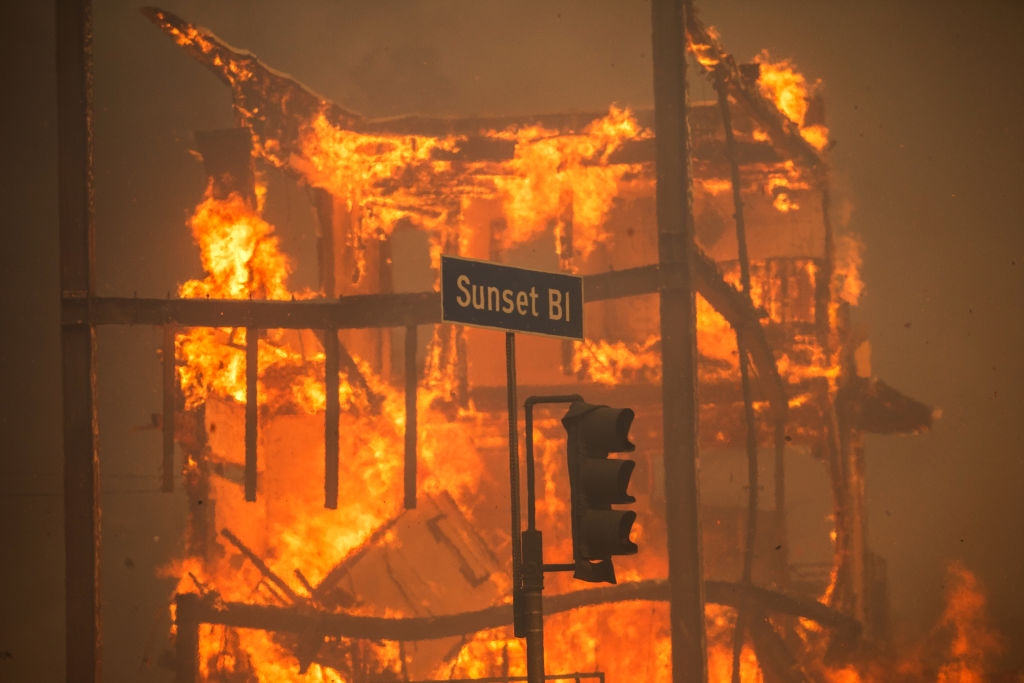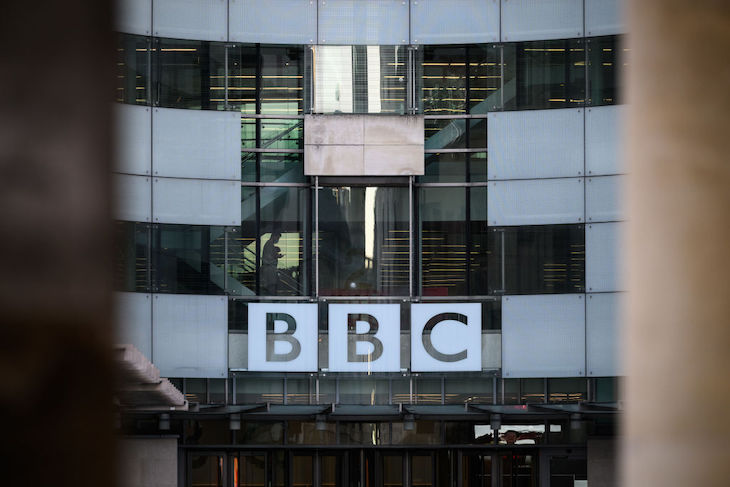Last year, I wrote here about the dark side of LA, after the Friends actor Matthew Perry was found dead in the hot tub of his $6 million Pacific Palisades house. I grimly predicted that his luxury ocean-facing bungalow – sold on to a developer for over $8 million just a few months after his fatal drug overdose – would become a new stop off on the ‘Movie Star’s Homes’ tours.
Was I wrong? The Perry multi-million glass bungalow narrowly avoided the flames. The LA wildfires have torn through the Palisades area, and have reached the very part of the Hollywood Hills where I used to live in the 1990s. Los Angeles Sheriff Robert Luna said that it looked as though ‘an atomic bomb dropped in these areas’.
Having lived as part of an expat British community out there in the 1990s, the cost cannot be simply measured in financial, human loss, or environmental terms.
This has been a week of seemingly irreversible damage to California’s place in the global psyche as a Land of Dreams, or the new Promised Land. Martin Amis phrased this appeal well in his novel Money when the Mid-Atlantic narrator John Self declares: ‘California, land of my dreams and my longing’.
It was the promise of this West Coast paradise – a City of Angels but with liberal sexual mores and large pay packets – which allured so many Brits from the 1950 generation of Christopher Isherwood, to the 1970s influx of the likes of David Hockney and Dudley Moore. When Isherwood – who lived at 145 Adelaide Drive in Santa Monica, just down from Palisades – was once asked to defend LA to LA-sceptics he replied: ‘Either they understand it’s the only place or they don’t’.
This also applied to the wave of middle-class (white) Americans who built new lives in suburban southern California in the 1950s – the world of Spielberg – when LA was still a dream factory of orange farms, sun and a powerful symbol of national post-war prosperity.
As the famous LA urban historian Mike Davis wrote:
A well-paid job in the aerospace industry and a ranch house in a sunny subdivision, only minutes from the beaches and Disneyland, was the lifestyle against which other Americans measured the modernity of their towns and regions. Millions of Americans, especially the young, envied those lucky enough to live in the Land of Endless Summer.
The dream was beginning to die by the end of the 1990s. That decade had seen the riots that had the city burning and under curfew (I covered them for this paper from the safety of the Playboy Mansion), the OJ Simpson trial which stoked further racial divisions, and then the 1994 Northridge earthquake. By 1998, Davis wrote that metropolitan Los Angeles, with its estimated 500 gated subdivisions, 2,000 street gangs, 20,000 sweatshops and 100,000 homeless residents, had become a ‘dystopian’ and ‘demonic’ symbol of Dickensian inequalities and racial contradictions in a region ‘where the future has turned rancid’.
I lived through this all. When I headed out to LA as a young reporter in September 1991, I arrived with all the preconceptions of somebody brought up enjoying The Graduate (set in the San Francisco area), The Eagles’ album Hotel California, and TV shows like Baywatch. I ended up living in a house at 7357 Woodrow Wilson Drive, near Mulholland Drive, next-door to David Hockney who would take me to test out his ‘Santa Monica Mountain Driving Tour’. He’d blast out carefully curated Wagnerian opera from the powerful stereo in his convertible Mercedes coupe as we slowly cruised through the mountain canyons, turning up Sigfried’s Funeral Music in the Ring as we approached his beach cottage in Malibu at the bottom of Las Flores Canyon. All one would have seen this week would have been an inferno of flames and smoke.
Within just two weeks of arriving, however, I found myself walking through the remains of the Oakville firestorm in the East Bay Hills area of Northern California. The fire killed 25 people, and destroyed 2,843 single-family dwellings at a cost of $1.5 billion.
I will never forget spending the night with hundreds of suddenly homeless people in a temporary shelter and hearing the cries of sobbing all night from families who had lost everything. I imagine it is much the same today, although the richer victims are reportedly holed up in swanky $1500 hotels like the Peninsula and Four Seasons drinking the bars dry in despair. Many have not got insurance, or inadequate policies to cover the losses.
State Farm, the state’s largest insurer, recently cancelled 30,000 policies including 1,600 in Palisades, saying they were at risk of ‘financial failure’ due to the fire risks. This meant that residents only had the option of ‘no insurance’ or getting insured under the State’s Fair Plan, which only covers buildings up to $3 million. For many this means personal ruin after a lifetime of work.
Yes, California is meant to be the land of re-invention but LA is no longer a city of ‘longing’. Certainly, the Brit-in-LA dream is dead. British expat numbers are now down to around 200,000. When I lived in LA, the British Consul-General estimated more like 400,000. At the time of the Heidi Fleiss hooker scandal in 1994, I learned that a surprisingly large number of ‘working girls’ in LA were British. In the 1990s’s Santa Monica was almost like an expat colony with darts matches at Ye Old King’s Head’ English Pub, tea-shops where you can buy old Dad’s Army DVDs and jars of Bovril and bars which opened early on a Saturday for watching the Premier League football.
The Brit-in-LA dream is dead
Now, the bar for even working in LA is getting difficult. Expats in the ‘industry’ are now finding it much harder to get an ‘0-1’ work visa, let alone a Green Card. Stylists, stunt men, ‘below line’ producers have to pull together as many as 50 letters of professional recommendation to get a visa, often only giving up to a year of work time. It’s also so much more expensive to live in LA than in the 1990s. Gore Vidal had a beautiful large old Spanish villa house just a canyon away from where I lived that was for sale for $440,000. Now it would be in the millions.
The other worrying thing about the fires is their cause. The TV news pictures have made LA resemble a cross between Mad Max and a Towering Inferno-style disaster movie. The Guardian wasted no time in blaming the fast-spreading fires, fuelled by unusually strong Santa Ana winds, on ‘a new era of complex, compound climate disaster. Conditions for a January firestorm in Los Angeles have never existed in all of known history, until they now do’.
Yet, there is every possibility that at least some of the fires may have been started on purpose. Residents in ‘the Palisades’ have reported that the fire started in a ‘walking trail’ area that had no pylons or usual fire hazards. A man has already been arrested under suspicion of arson in the wealthy suburb of Calabasas. The death of the South California dream may be as much to do with sabotage than unseasonal winds.







Comments